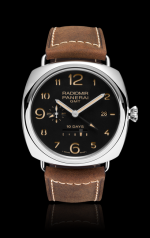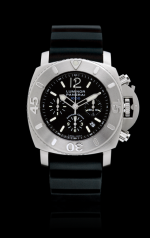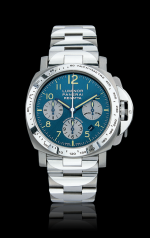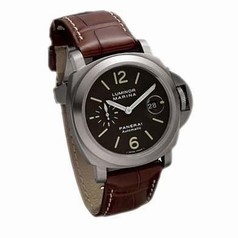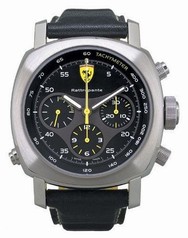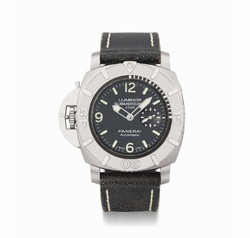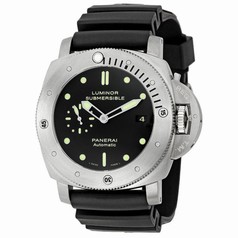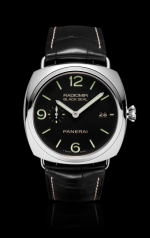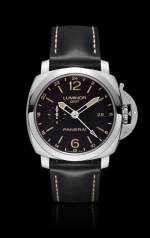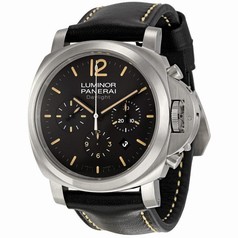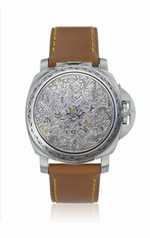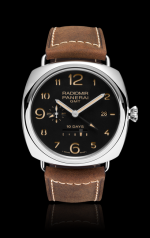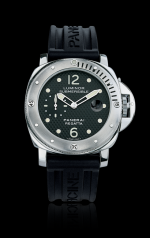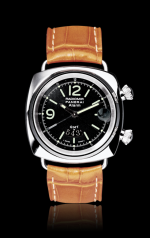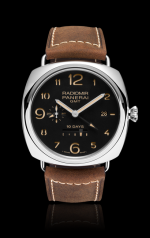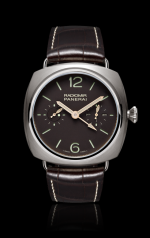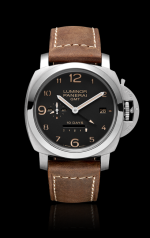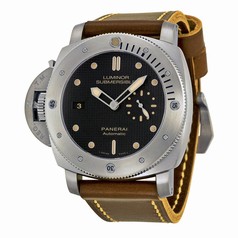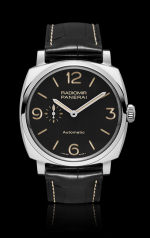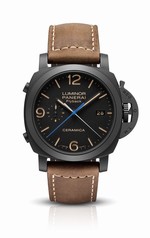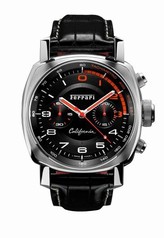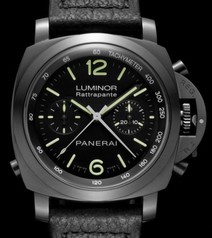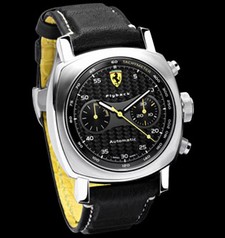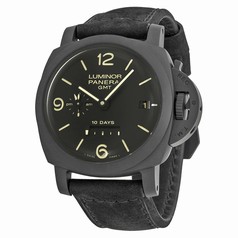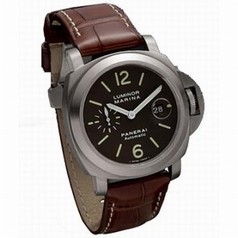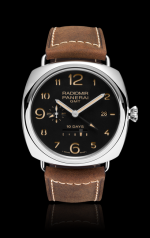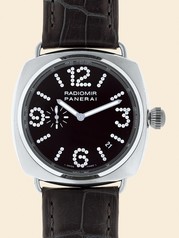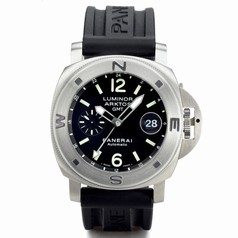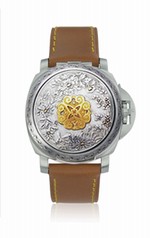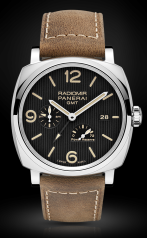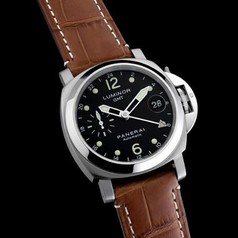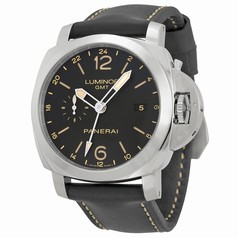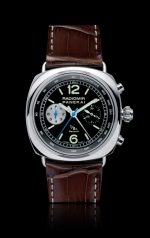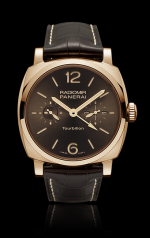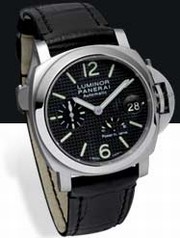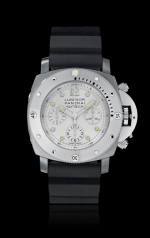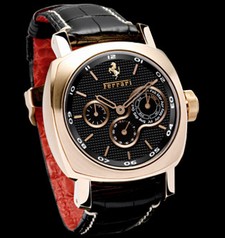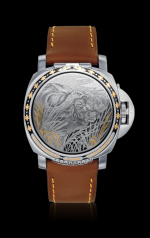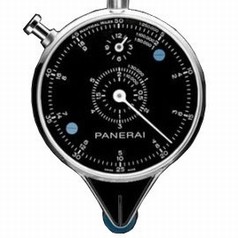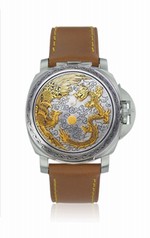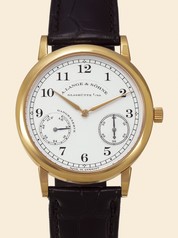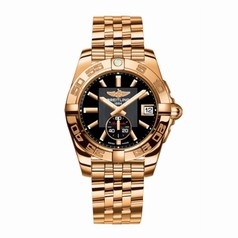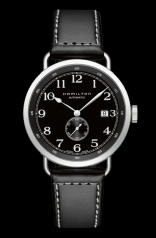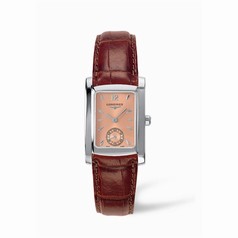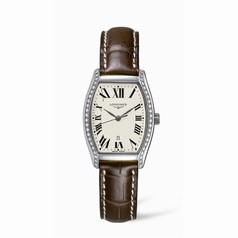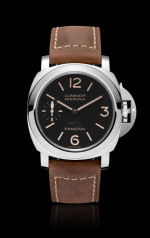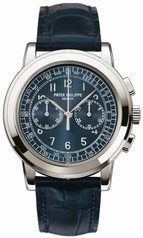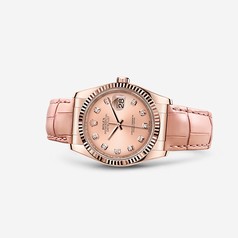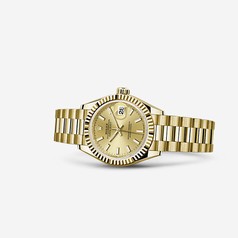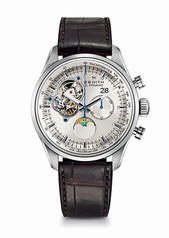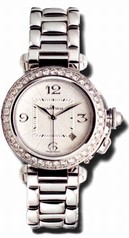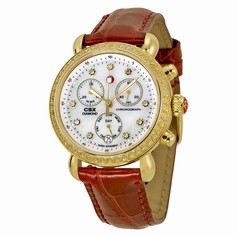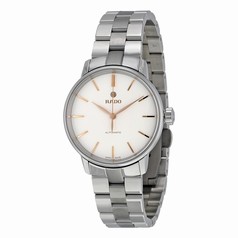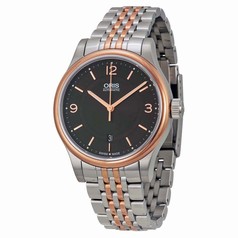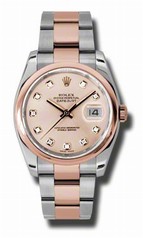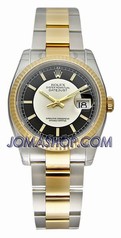-
Panerai - Radiomir 1940 10 Days GMT Automatic, oro rosso, 45 mm
Officine Panerai presents the Radiomir 1940 10 Days GMT Automatic in two new exclusive Special Editions. The Radiomir 1940 design is for the first time combined with the P.2003/10 manufacture movement, the automatic calibre with date, GMT function and a power reserve of a full ten days, which is presented for the first time in a skeletonised version.
The 45 mm Radiomir 1940 case is made of 5NPT red gold and is water-resistant to 50m. The dial - available in brown or black - has an elegant satine soleil finish and the famous sandwich structure invented by Panerai to provide the maximum visibility and legibility of its indications even in very low lighting conditions.
Designed, made and decorated in the Panerai Manufacture at Neuchâtel, the P.2003/10 movement is the first skeletonised automatic movement from Officine Panerai. Measuring 31 mm, it has three spring barrels, 25 jewels and a balance which makes 28,800 vibrations per hour (4 Hz). Its functions are hours, minutes, small seconds, date and linear indication of the remaining power reserve at 6 o'clock, as well as a second time zone displayed by an arrow hand, with the relative AM/PM indication on the counter at 9 o'clock.
The mechanism can stop the balance and zeroes the seconds hand as soon as the winding crown is pulled out; it also enables the local time hand to be adjusted forward and backward in jumps of one hour at a time, without stopping the minute hand or interfering with the running of the watch, but automatically adjusting the date.
The artistic aspect consists of the delicately worked skeletonising, which reveals the complexity and sophistication of the movement. The rotor of the oscillating weight is grooved and embellished with the engraving inscription "Officine Panerai" on the outer edge. Beneath the rotor, which rotates in both directions, the skeletonised bridges and barrels can be seen, which reveal the technical structure of the various components and their chamfered and polished edges.
-
Panerai - A Panerai clock for Expo 2015
A large Panerai wall clock, with the iconic minimalist design which makes every timepiece of the Florentine brand immediately recognisable, enables anyone entering the Info Point at the Expo Gate at Piazza Castello to read the time in Milan and five other world capitals, chosen for their international vocation and their connection with Universal Expositions: London, New York and Paris (seat of the BIE, the Bureau International des Expositions) and also Shanghai and Dubai (hosts respectively of the last and the next Universal Expositions).
Like all the brand's timepieces, the clock provides exceptional visibility at night, making it legible even in darkness, and it is therefore visible at all times from outside the Info Point, thanks to the building's ethereal structure of transparent glass and tubular steel.
This summer, Officine Panerai will also completely renew its Milanese boutique at Via Montenapoleone 1. The boutique is currently being restyled and enlarged under the supervision of the designer Patricia Urquiola, creator of the new concept already incorporated in the Flagship stores recently opened in Florence, Hong Kong, New York and Paris.
-
Panerai - Radiomir Firenze 3 Days Acciaio - 47mm
The Radiomir Firenze is entirely hand-engraved by Italian master craftsmen, making each timepiece unique. Its design is inspired by motifs existing in the Florentine iconography. Similar to the inlays adorning the marble facades of the Florentine's churches, the engravings enhance the elegant structure of the case, enfolding the case-band and the crown. Shaped by the master craftsmen, the lines appear to form geometric figures creating a harmonious piece. Some symbolic details stand out, such as the Florentine lily, emblem of Firenze.
The engraving is entirely done by hand, and each case takes one craftsman more than a week to finish. The geometric and floral motifs are first drawn as a temporary outline - using powdered chalk or magnesium powder - and then engraved with a burin. The engraved surfaces are formed of very thin parallel lines, giving depth to the design and accentuating the contrasts between light and dark.
The new Radiomir Firenze houses a hand-wound mechanical, P.3000 calibre, executed entirely by Panerai and visible through the sapphire case-back. Two mainspring barrels, connected in series, provide 3 days of power and the balance wheel oscillates at a rate of 21,600 vibrations per hour. The P.3000 movement is equipped with a system that allows the adjustment of the hour, through the decorated crown, without interfering with the running minutes or the timekeeping of the movement. Consistent with its origins as a watch originally designed for military use underwater, the new Radiomir Firenze (PAM00604) is water-resistant to 100 metres. It is supplied with a black alligator strap.
The Panerai Radiomir Firenze is limited to 99 pieces and is only sold at the Florence boutique in Italy.
-
Why not...? - The Panerai PAM 590
We are in Egypt, 600 years before Christ.
The Pharaoh's wise men have just developed a new instrument for reading the time. It is called the Merkhet. Its original construction allows it to read the time even after sunset. With this invention, man can start to tell the time even in the black of night. And this will allow him to improve the precision of time reading.
Nowadays this story seems outmoded or confined to archaeology books. There is light everywhere and the time can be read in any conditions. Even at night, the light shines…
But things have not always been so. Not so long ago, in fact, the ability to read the dial of a watch was of crucial importance. And, as is so often the case, it was war that created this need.
On the night of 20th December 1914, the French Farman MF 11 were the first bombers to fly at night. The ability to read flight instruments in complete darkness thus became a strategic priority.
From 1917, the American Defense Department decided to order luminescent watches from the US Radium Corporation, which used radium paint for the luminescence. History recalls above all the struggle of the "radium girls", who spent their days painting watch dials with radioactive substances, with the health effects that we can imagine.
But at the time, this production was strategic… and it remained so for a long time.
At the dawn of the second world war, such instruments that were readable at night were no longer needed just in the air. Night could also appear in the middle of the day - you just had to dive under water.
We now move to Italy, where a few men understood that underwater combat could offer a precious advantage in the case of conflict. They followed the example of two of their predecessors, Major Rossetti and Lieutenant Paolucci, who became the first combat swimmers in history, when they sunk an Austro-Hungarian cruiser in the port of Pola in November 1918.
Inspired by this feat, their comrades wanted to dive discreetly, swim towards their targets, destroy them and then disappear. They became the first combat swimmers of the 10th MAS flotilla.
In order to operate at night and underwater, the members of the MAS flotilla needed equipment that was both reliable yet innovative, including genuine diver's watches that were both water resistant and legible. And it was this latter aspect that needed the most work. One of the officers in the flotilla heard about a watch workshop in Florence. He visited it and met Guido Panerai. Together, they decided to develop a watch that would meet the requirements for future operations by the Italian swimmers.
Once again, radium was called to the rescue. Panerai developed a water resistant watch with two superimposed dials: one was hollowed out with large 12, 3, 6 and 9 numerals and the other was covered with radium. They were fitted into an oversized case that was 47mm in diameter and housed a Rolex movement.
The Radiomir was born.
This is where the story starts. Italy's combat divers started operations. Their exploits inspired navies all over the world. And they wore new versions of the Radiomir. By the end of the conflict, Panerai had produced just over a thousand watches, but this remained a military secret for years to come.
In order to keep its market share, the Florentine brand improved its Radiomir models and looked to other countries that called upon the services of former combat divers from Italy. But the technical specifications did not change: legibility and water resistance.
The dangerous radium was soon replaced by a new substance based on tritium: luminor. The water resistance of the newer diver's watches was also improved by a new crown protecting bridge, which is today affectionately known among fans as the "bottle opener".
But it is once again an aspect of light that gave the new watch its name: the Luminor.
Still today, the Luminor and Radiomir models dominate the Panerai catalogue. They are no longer military secrets but they still keep their unmistakable DNA, a mixture of industrial design, operational simplicity and Latin charm.
Luminor or Radiomir. The choice appears simple. Yet it is decidedly complicated. In the end, I opted for a Luminor that is particularly dear to my heart: the PAM 590. It is the link between the past and the present, bearing a seal that is famous in the brand's history, and was launched this year as a limited edition. It is the embodiment of what I think a true Panerai should be.
Why Panerai ?
The Luminor and Radiomir are the two emblematic models of the brand, which was relaunched in 1993 and incorporated into the Vendôme group in 1997 (which later became the Richemont Group). Officine Panerai has since experienced an astonishing rise to fame.
Even though its history is not as long as that of many of the famous Swiss brands, Officine Panerai has managed to exploit it in an almost unique way, using the techniques of Hollywood to build up its muscled up Radiomir and Luminor models in the style of the Expendables, order its collections like sequels or even prequels and grab the attention of an appreciative and particularly expert audience by developing its models in very small steps.
The brand has not only imposed its unique style, it has also liberated wrists by daring to offer 44mm diameter cases from the start of the 1990s, then relaunching the original 47mm cases at a time when 39mm was the norm.
Furthermore, Officine Panerai probably invented the concept of special editions and still today manages to generate both excitement and frustration among fans and yet still be forgiven! Although the concept is now found in overabundance among its competitors, whose initiatives are not always successful, the Officine can delve into its history - and the abundance of prototypes and variants in its production - to surprise and constantly nurture the legend.
The Panerai Luminor PAM 590: From the US with love!
The first version of the Luminor dates back to 1950. At the time, this diver's watch had a diameter of 47mm and a case that was rounder than that of the current 44mm Luminor models. In order to highlight the difference, a few years ago Panerai produced a version similar to the original model: the PAM 372.
But let's get back to our contemporary Luminor. It means a lot in the recent history of the Officine, because Panerai re-entered the watch market with a similar model in 1993. Before 1997 and the acquisition by the Vendôme Group, which later became Richemont, Panerai produced several versions of its Luminor with a concession to its predecessor: its size shrunk from 47mm to 44mm.
Offering a 44mm watch in 1993 was already very audacious. Panerai would wait a few more years before re-issuing its legendary 47mm model.
In order to lure future customers, the teams at Panerai decided to recreate the Luminor. The task was entrusted to Alessandro Bettarini, who designed a new case that was more angular than the original and had slightly reduced proportions. The success of this new version was such that Paneristi (as fans of the brand are known) call it the Bettarini.
The Bettarini is still listed in the Panerai catalogue but at the SIHH in 2014 the brand presented a new version, still at 44mm diameter, but with a more refined profile. The PAM 590 uses this new case.
Another major change is the movement. Since 1993, Panerai had been using Unitas movements in its Luminor models, which fitted well with its image as an assembler of tool watches. But, following its competitors, the brand presented its first "in house" movement, the P2002, in 2005. A long series of new movements followed until the hand-wound P5000 movement was launched in 2014, with an eight-day power reserve. Thinner than the Unitas, this movement allowed the Bettarini case to shed some weight.
It is the impressive power reserve that makes the Panerai PAM 590 so interesting. It bears the inscription "8 giorni brevettato" on the dial, which first appeared in 1950 on a Luminor Submersible produced for the Egyptian navy. At the time, the watch was fitted with an Angelus calibre.
The "8 Giorni" name stuck and still gets collectors salivating. Panerai has only launched a few models with this logo on the dial. The PAM 590 is one of them, which gives it even more charm.
The dial hides another interesting feature of the 590. Like all Panerais it is simple and loyal to the principles of legibility. The 9 is replaced by a small seconds counter. But if you look closer you will see that the colour of the hour markers is different from the colour of the "Luminor Panerai" text or the "8 Giorni" logo. The hour markers are orange, the text is white.
In Panerai culture this is known as a "non-matching" dial. It is an allusion to the first watches of the pre-Vendôme period (before the acquisition by Richemont), on which some white luminous hour markers would quickly change colour on exposure to the sun, creating a difference in colour between the (non-luminescent) inscriptions on the dial and the hour markers. What was originally a quality issue thus became a genuine Holy Grail. Some dials were replaced but other owners kept their watches as they were, thus creating a buzz about "non matching" dials that now makes them sought after because they are original.
The Panerai PAM 590 takes on this characteristic and therefore has a dial inspired by vintage models. Another reason to fall for it.
In summary, our Luminor has a "Bettarini" case, a "non matching" dial and an "8 Giorni" inscription.
At the start of this review, these terms may not have got your attention. But now that you have become Paneristi, you know why this Panerai PAM 590 is so special.
And if I add that in 2014 it is only available in the USA, I create both frustration and expectation.
Welcome to the world of Panerai!
What does the devil's advocate think?
A Panerai is recognisable, easily identifiable. This is both its strength and its weakness. The uninitiated will quickly say "OK, it's a Panerai". But the strength of the brand is in the subtlety of the changes it has made to its models from one year to the next. And this subtlety is sometimes… too subtle! You need time to appreciate the difference in colour of the hour markers, the orange of some numerals compared with the sandy yellow of others. Or the shape of a hand that recalls a particular model of 1942, compared with one from 1943! And there are numerous other examples.
A Panerai, therefore, is not just a watch. It is an object that you have to get to know, and that takes time. It will help you to get to grips with a phrase that angers any enlightened fan: "they are all the same!".
What image does the wearer of this Panerai project?
A Panerai is a "tool watch", an instrument for work invented to serve a particular purpose. It was born to be functional and effective, not to please. And that is precisely why it does please!
If the wearer of this PAM 590 is able to explain the distinguishing features of this model compared with another Luminor, he will already have come a long way and will be considered an expert rather than someone who has simply given in to a particular fashion.
Another point that is specific to Panerai watches: their ability to "accept" all kinds of leather straps. The Luminor is particularly versatile in this regard and has helped to build up a "strap culture" that is specific to the brand.
So if you really want to show that you are an aficionado, nothing could be simpler: forget about the strap supplied with the Panerai 590. It's not that it's ugly in any way, just that you should not keep it! That's the way it is. Choose a 74 instead, which will suit it very well.
You don't know what a 74 is?
Then you still have some ground to cover in your Paneristi education!
It's up to you to find the answer…
-
Free Time - They're crazy about... sailing!
Gmt n°29 - Fall 2012
Angelo Bonati, CEO of Panerai
Brice Lechevalier: When did this passion for sailing emerge ?
Angelo Bonati: It goes back to my childhood, when I lived in the country and was fascinated by the sails when I saw them on TV. I wondered how it was possible for them to float in the wind. Unfortunately, the years rushed by all too fast, and it was only after I turned 30 that I was able to take lessons on Lake Como.
What's your best memory in this domain ?
The first boat I bought, a Jeanneau..
And as far as regattas are concerned?
I love the sea but I don't do much competitive sailing. I have excellent memories of a leg raced at 15 knots on the historical Bona Fide tall ship during the Regates Royales de Cannes a few years ago.
Of which achievement are you most proud ?
Of the restoration of Eilean, a ketch built by the Fife shipyard in 1936 and brought back by Panerai from Antigua in 2006 in order to be entirely renovated in keeping with tradition. It took us two and a half years in order to restore its original understated elegance, a period that taught me a lot. It is a symbol of the love of the sea that only sailing can fully express.
What would be your ultimate dream ?
To sail around the world on a monohull, to get to know all the many seas and to meet people on the other side of the world - while taking time to stop wherever I feel like it and for as long as I like.
What do you think of the 34th America's Cup ?
I have no opinion about it and am not even following it. They have totally destroyed a proud tradition.
How does this passion influence your professional activity ?
It's not really a matter of influence, in that I definitely distinguish between the two. I am lucky to be able to manage a brand with b maritime connections, and I am able to bring to the table my knowledge of this milieu. But even though it's pleasant, it's still work. The latter only stops when I'm aboard my boat.
Denis Flageollet, co-founder of De Bethune
Brice Lechevalier: When was this passion for sailing born ?
Denis Flageollet: When I was a child, the carpenter's workshop that made fishing boats out of pine and larch wood was 100m from my grandfather's watchmaking workshop and it smelt nicely of a combination of wood and tar and I loved watching him work. My father used to take me fishing on the lake where I always saw orange sail boats that I found incredibly attractive. After making a number of models that irritatingly sank, at about 12 years old I was finally able to sail. Even if it was only the boring but famous Vaurien designed for Glenans sailing school, it was still an adventure for me and an extraordinary discovery of the elements.
What is your favourite memory ?
The first time I crossed the raz de Sein (in Finistere) during the full moon under a spinnaker with a Sparkman & Stephens built by Rasmussen in 1954, of which only a very few examples still exist in the entire world.
What achievement are you most proud of ?
The single-handed restoration of a Shark made of mahogany in 1960! I stopped counting my hours after 1000 and I have now been renovating it regularly for more than 40 years.
What would the ultimate dream be ?
The Everest of sailing - the Vendee Globe - although it would obviously be totally inaccessible at my level. Imagine yourself alone for even a single night on a 60 foot Imoca going flat out in the Southern Ocean !...
What do you think of the 34th America's Cup ?
I think it is a great technological and human challenge. I appreciate the fact that the race is going back to one design sailing and a lot of regattas are planned, from the World Series to the final of the America's Cup.
How does this passion affect your professional life ?
This activity helps you to free up your head immediately, and to take time out. It's a school of patience that encourages introspection. These are virtues that are indispensable to balancing a tough professional life
-
Panerai - In The Lab
IW Magazine - 1st November 2011
If there is one Italian phrase that those familiar with Panerai watches already know, it is Laboratorio di Idee. This mantra, literally "Laboratory of Ideas," is the governing philosophy at the heart of this luxury watchmaking company. Panerai prides itself on creative virtuosity, and over the course of its long history this unique philosophy has borne diverse fruit in the form of compelling watchmaking firsts, from the 1936 premiere of the Radiomir luminous watch to the more recent invention of a scratchproof ceramic-like case material called Panerai Composite, a material that enjoys the benefits of aluminum's lightness and high-tech ceramic's scratch resistance.
Though the Laboratorio di Idee slogan could be interpreted as a metaphor for all of Panerai's operations—the design and marketing team based in Milan, the Swiss movement production and assembly near Fleurier and in Neuchâtel, and even the carefully curated shopping experience provided at worldwide boutiques—the phrase is never more apt than when used to describe Panerai's Neuchâtel-based R&D department, which is responsible for furthering the Panerai legend by harnessing cutting edge technologies.
Growth
Over the past decade or so, Panerai has grown impressively in two key areas: the first has been to achieve an enviable degree of vertical integration in its movement production—to the tune of ten new movements since opening its Neuchâtel manufacture in 2002. In just short of a decade, Panerai has evolved from a "hot" design brand using only supplied movements into a respected manufacture, whose prolific invention of new calibers has caused the watch industry to take note.
More recently, however, observers of Panerai have witnessed a renewed level of attention paid to the Panerai watch case, the classic, oversized cushion shape on which the Italian design powerhouse built itself cult status. That's right, Panerai has a real cult following: They gather at least once a year in a different major city to celebrate "P-Day," and they call themselves the "Paneristi."
One need not figure among the Paneristi to know just how important those iconic case designs are to Panerai's image. Perhaps more than any other watch brand, innovations in case design have helped to shape the development of Panerai, from the wire lugged Radiomir to the bold, tough and highly water-resistant Luminor, with its iconic crown protector. And let's not forget who started the whole oversized watch case trend.
Materials
Over the last few years Panerai has pioneered a number of bold breakthroughs in case manufacture. It was last year that the firm came out with its first watch housed in proprietary Panerai Composite, a material formed when aluminum is immersed in an electrochemical bath; and it was just this year that Panerai released a watch that has become a true critic's darling, the Panerai Luminor Submersible 1950 3 Days Automatic Bronzo 47 mm.
According to Panerai, development of Panerai Composite watches resulted from a relationship that the firm forged in the high-end sports-automotive industry. Ceramacized aluminum was invented originally to shield parts of the engine. When the R&D department at Panerai learned of the material and its possibilities in case manufacture, it became very interested in being the first watch marque to take advantage of the metal's highly desirable attributes, including a phenomenal weight-to-strength ratio.
The new material also presented Panerai with a simpler, more effective method for producing scratchproof cases. Unlike high-tech ceramic, which Panerai forms into rough case shapes from zirconium powder and then machines into proper watch cases, Panerai Composite begins as a block of aluminum, which is machined into the case shape almost exactly as the firm would one of its steel watch cases.
It also helps the technicians achieve the right tolerances in fewer attempts: the holes for screws, for example, are right the first time. Other components can also be made in the Composite material to match the case, including the ardillon buckle and the caseback.
"Panerai Composite is the ideal material for the creation of watch cases, as it guarantees both comfort and great aesthetic qualities, resistance to knocks, scratches and high temperatures," Panerai CEO Angelo Bonati told iW. "Furthermore, Panerai Composite is ductile, allowing for complex geometries and processing, and is inert, so it does not change its structure or appearance over time."
Making cases
How exactly does Panerai turn aluminum into ceramic? As mentioned before, the process begins with an aluminum block, which Panerai machines just like steel. A technician puts the machined aluminum case into a chemical bath, through which a very high electrical charge is allowed to pass. When the charge passes through the liquid and the aluminum, a chemical transformation occurs in which the aluminum molecules of the case attach to the oxygen molecules in the bath.
The result is Al2O3, an aluminum-based version of ceramic. Depending on the case shape, the chemical transformation occurs approximately 40 to 70 microns deep: more than enough to prevent scratching, but not so deep that the lightness of the aluminum inside is compromised. (By way of comparison, the typical black PVD or DLC-coating found in high-end watchmaking is between one and two microns thick.)
To date, Panerai has made three timepieces from the new Panerai Composite. Last year the material made its debut in PAM 339, a 47-mm Radiomir-cased limited edition with eight days of power reserve from manual winding. The timepiece, powered by the in-house caliber P.2002, was the hottest limited edition that Panerai released in 2010 and was exceedingly difficult for many of Panerai's most devoted fans to get.
This year at SIHH, sensing the pent-up demand for Panerai Composite watches, the firm released two Luminor versions, one a special edition and the other an unlimited piece that joins the contemporary collection. The watches are available in 44 and 47 mm sizes, respectively.
The Luminor Composite 1950 3 Days 47 mm, the special edition, is limited to just 2,000 numbered examples. At 47 mm in diameter, the timepiece is a classic size for Panerai, and has the distinction of debuting the all-new in-house movement P.3000/1, a hand-wound mechanical caliber with a frequency of 21,600 bph and three days of power reserve. In addition to the case, the watch's winding crown, crown protector, bezel and buckle are all also made from Panerai Composite.
The other composite timepiece to debut this year is the Luminor Composite Marina 1950 3-Day Automatic 44 mm. This timepiece is powered by the in-house P.9000 automatic caliber, which offers 72 hours of power reserve from its two winding barrels. Among its more impressive attributes is its water resistance to 300 meters, all the more impressive because of the smoked sapphire crystal case back that enables an open view of the back of the movement.
The Bronzo
Among the biggest hits from any brand at the SIHH 2011 was the Luminor Submersible 1950 3 Days Automatic Bronzo. This 47 mm diver's watch marked the very first time that Panerai made a watch from bronze. The Paneristi and other fans of the brand enthusiastically applauded the Bronzo at its debut and clamored for it when its 1,000 examples were released, causing it to sell out very quickly.
Many in the industry cited the piece's rarity, in terms of its limited nature but also because there are so few bronze watches from any brand on the market. According to Panerai, the inspiration for the Bronzo came from the firm's longstanding sponsorship of the Panerai Classic Yachts Challenge, an international circuit of classic yacht regattas, and the recent restoration of a very special classic yacht, Eilean, which the firm oversaw and funded.
"As often happens with Panerai, our inspiration comes from the sea, and in particular from the world of classic yachting, which we are deeply involved in through our sponsorship of the Panerai Classic Yachts Challenge," Bonati told iW in an interview.
Nautical influence
If you were to board Eilean, and walk along her wooden deck, you would see gleaming bronze and brass fittings and instruments dotting her surface. The Bronzo, a tribute to the instruments of classic yachting, also gleams when it is delivered to its customer. But its appearance from that point on can go in any number of directions.
Over time, the watch's bronze case develops a unique patina, with a number of factors contributing to just how deep that patina will go. These factors include but are not limited to the frequency one wears the Bronzo, the oils and acids of the wearer's wrist, and the climate in which the watch is worn. In this sense, the Bronzo is a living timepiece that evolves with the wearer and becomes, over time, more and more his own.
If, as is often asserted, an individualized experience is central to luxury, then the Bronzo, with its limited production, is one of the most luxurious timepieces one can buy.
According to Panerai, manufacturing a bronze watch is no more difficult than machining steel or aluminum. However, the real difficulty in producing and delivering the Bronzo to Panerai customers is in the handling. Because the Bronzo is "living," an errant fingerprint or other accidental touch to human skin can start an unwanted patina on the case.
Therefore, everyone who touches the Bronzo—during machining, casing, testing, shipping and even retailing—must wear protective gloves.
Panerai sees the Bronzo as an ultimate collector's piece, for informed buyers who understand that the case is supposed to change color and texture. That being said, Panerai has not ruled out the possibility of more bronze editions in the future, a development that would please collectors.
Ceramic
High-tech ceramic is a well-established material in haute horlogerie. Panerai's preference for durable, sporty watch cases makes it a natural brand for making stealthy, stylish and sporty ceramic watches. Had ceramic watch case technology existed in the 1930s and 1940s, the Italian Navy might have commissioned just such a sleek diver's timepiece from its preferred instrument supplier.
Today Panerai makes its ceramic watches from zirconium oxide, which it obtains by pressurizing the material in powder form, to achieve a uniform, even appearance, and very high quality. The method is a far cry from the less costly ways ceramic cases are produced, such as injecting the material into a mold.
This year, Panerai has cased its P.2002/3 in-house movement in a 45 mm ceramic Radiomir case to create the Radiomir 8 Days Ceramica. The watch has a completely black look, from the case, bezel and dial to the DLC-coated pin buckle and buffalo leather strap. Even the sapphire window onto the in-house movement is smoked, reinforcing the all-black appearance of the Radiomir 8 Days Ceramica.
Though perhaps not as rare as some of the other materials that Panerai uses for watchmaking, titanium remains one of the best materials for making large, sporty watches because of its excellent weight-to-strength ration. This year Panerai presented a left-handed monopusher chronograph in a Luminor case, the Luminor 1950 Monopulsante Left-Handed 8 Days Titanio 44 mm.
Powered by the in-house P.2004/9 manual-wind chronograph caliber. With three spring barrels powering timekeeping and the monopusher chronograph, this timepiece is anything but underpowered.
As we've seen, Panerai offers one of the widest ranges in materials of any firm in the high-end watchmaking sector. With composite, bronze, ceramic and titanium to choose from, collectors in search of a high-end watch with real originality will find no shortage of options. Of course, Panerai continues to make several best-selling models in steel, as well as the occasional gold and platinum timepiece. And as we've seen in recent years, many of these cases surround in-house movements—another facet of the firm's manufacturing research and development that will undoubtedly reward Panerai collectors again in just a few months as the firm's 2012 models debut in Geneva.
-
Panerai - L'Astronomo
Dedicated to fans of technical grand complications, the Luminor 1950 Equation of Time Tourbillon Titanio - 50 mm by Officine Panerai is a tribute to the genius of Galileo Galilei, a combination of some of the rarest, most exclusive and fascinating specialities in watch-making.
Produced in just 30 examples, the Luminor 1950 Equation of Time Tourbillon Titanio - 50 mm is the most technically sophisticated wristwatch ever produced by Officine Panerai: a tourbillon with equation of time, indication of sunrise and sunset times for the city chosen by the purchaser and depiction of the night sky of the same city on the back plate.
The watch functions are immediate and clear on the dial: a date window at 3 o'clock, alongside a tiny dial that shows the month with a hand; sunset time; equation of time; sunrise time and finally small seconds at 9 o'clock, where the rotation of the tourbillon with a tiny ecru disc is visible through a small dial. Times for sunrise and sunset are shown by two cursors that run along numbered circular sectors and vary depending not only on the seasons but also on the latitude chosen by the purchaser. The dial has the classic Panerai sandwich structure, guaranteeing exceptional night-time visibility thanks to the luminescent substance inserted between the two layers.
Equation of time is the difference between the time shown by the watch, which is that universally adopted for ease and real or solar time, which varies every day due to the eccentricity of the Earth's orbit and the inclination of its axis. 4 days a year, these two times coincide perfectly but on all the other days they actually differ by up to 15 minutes, either faster or slower. The linear cursor at 6 o'clock immediately shows this time difference and this calculation is a speciality of top-end watchmaking and a feature that very few watches have.
Other indications can be seen through the sapphire glass on the lower part of the movement P.2005/G, based on the Officine Panerai P.2005 in-house calibre, modified to include new functions. With 375 components, the P.2005/G calibre features a typical Panerai tourbillon regulator, which can be admired from the back, turning on an axis perpendicular to the axis of the balance and making two rotations a minute, instead of one. With three spring barrels, it has a manual-wound movement and ensures 4 days' autonomy, with the remaining power reserve shown by a hand, this too visible on the back.
The last hugely fascinating element that completes the personality and refinement of this model, is the map of the sky on the lower part of the mechanism. The disc that shows the map rotates in one direction or the other, depending on the hemisphere chosen, thus constantly updating the night sky above the city chosen by the purchaser. The name of the city is also engraved on the back, together with the millesimation.
The watch's Luminor 1950 case is 50 mm in diameter, in titanium so that it weighs less, but clients can also choose a pink gold case. Waterproof to 10 bar (about 100 metres), the case has the typical crown-protecting bridge, brushed titanium like the case body, while the anti-reflective sapphire crystal is held in place by a bezel with contrasting polished finish.
The Luminor 1950 Equation of Time Tourbillon Titanio - 50 mm comes with an alligator strap and the classic buckle customised with the Officine Panerai logo.
-
Book - Panerai watches from 1936 to 1997
PANERAI WATCHES FROM 1936 TO 1997.
PANERAI IN FLORENCE - 150 YEARS OF HISTORY
Authors: Mario Paci & Dino Zei
2 large volumes (25,5 x 31,5 cm.) with a total of more than 780 pages in an elegant slipcase
CHF 768 / € 480
English / Italian
Limited edition of 1500 numerated examples
These two books represent the most complete reference work ever done on PANERAI.
The authors Mario Paci (Quality Assurance manager until 1997) and Dino Zei (Director of Officine Panerai Spa) show us the best of the Panerai production, focusing on the most interesting divers watches such as RADIOMIR, LUMINOR, MARE NOSTRUM and the 6152 watch with Rolex dial. These books also describe the models EGIZIANO, EGIZIANO PICCOLO, DOPPIA LEVA (DOUBLE LEVER), LUMINOR MARINA MILITARE, different prototypes and Surface homing systems.
Furthermore, they specify the filed patents and the main products made until 1999, many curiosities about the creation of the company, the passage of the watch division to Cartier and the relinquishment of Panerai.
These 780 pages allow the collector to have a complete and deep vision of the production of this prestigious and historical brand which represents nowadays an icon not only in the watches field but in the fashion industry as well. Many actors and celebrities in fact appeared with a Panerai watch at their wrist (i.e. Silvester Stallone, Demi Moore, Bruce Willis, Sharon Stone, Carol Alt, Arnold Schwarzenegger, Gabriel Batistuta, Alessandro Costacurta and Alberto Tomba).
ORDER THE BOOKS

